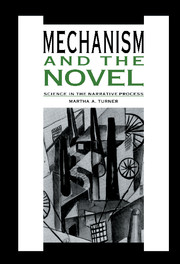Book contents
- Frontmatter
- Contents
- Acknowledgments
- 1 Introduction
- 2 The concept of mechanism
- 3 The Aristotelian logic of settlement in Austen's Pride and Prejudice
- 4 Scott's The Bride of Lammermoor: empiricism, mechanism, imagination
- 5 Cosmology and chaos in Dickens's Bleak House
- 6 Scientific humanism and the Comic Spirit: from The Ordeal of Richard Feverel to The Egoist
- 7 Old mindsets and new world-music in Conrad's The Secret Agent
- 8 Women in Love: beyond fulfillment
- 9 The mechanistic legacy: Lessing's Canopus in Argos: Archives
- Notes
- Bibliography
- Index
3 - The Aristotelian logic of settlement in Austen's Pride and Prejudice
Published online by Cambridge University Press: 19 January 2010
- Frontmatter
- Contents
- Acknowledgments
- 1 Introduction
- 2 The concept of mechanism
- 3 The Aristotelian logic of settlement in Austen's Pride and Prejudice
- 4 Scott's The Bride of Lammermoor: empiricism, mechanism, imagination
- 5 Cosmology and chaos in Dickens's Bleak House
- 6 Scientific humanism and the Comic Spirit: from The Ordeal of Richard Feverel to The Egoist
- 7 Old mindsets and new world-music in Conrad's The Secret Agent
- 8 Women in Love: beyond fulfillment
- 9 The mechanistic legacy: Lessing's Canopus in Argos: Archives
- Notes
- Bibliography
- Index
Summary
When Jane Austen began writing Pride and Prejudice (1796), Sir Isaac Newton had been dead some seventy years. His Principia Mathematica was published in 1687. The atomistic-mechanical model embedded in Newton's works was firmly established by Austen's day in studies of human nature and human behavior as well as in the physical sciences. Locke's Essay Concerning Human Understanding appeared in 1690. Jeremy Bentham began publishing his doctrines of “utility” in ethics and politics during the mid-1770s. Bentham's disciple James Mill (1773–1836) was almost exactly the novelist's contemporary (Austen was born in 1775 and died in 1817). According to Floyd W. Matson, “By the close of the eighteenth century Newton's method, the method of causes and mechanisms, had become standard procedure throughout the respective sciences of nature, of life and of man.” Similar intellectual currents made themselves felt in British social life. Reform societies composed mainly of artisans and tradesmen began appearing in urban areas in the early 1790s. These societies, often fueled by ideals of atomistic individualism, supported the egalitarian goals of the French Revolution and criticized the British government for failing to protect the rights to liberty and secure property for all its citizens. Newtonian modes of thought began to find favor with certain segments of the aristocracy during this time as well. Scientific organizations such as the Royal Institution (founded in 1799) provided interested landlords with the latest findings in chemistry and biology for use in their agricultural and mining concerns.
- Type
- Chapter
- Information
- Mechanism and the NovelScience in the Narrative Process, pp. 43 - 62Publisher: Cambridge University PressPrint publication year: 1993

